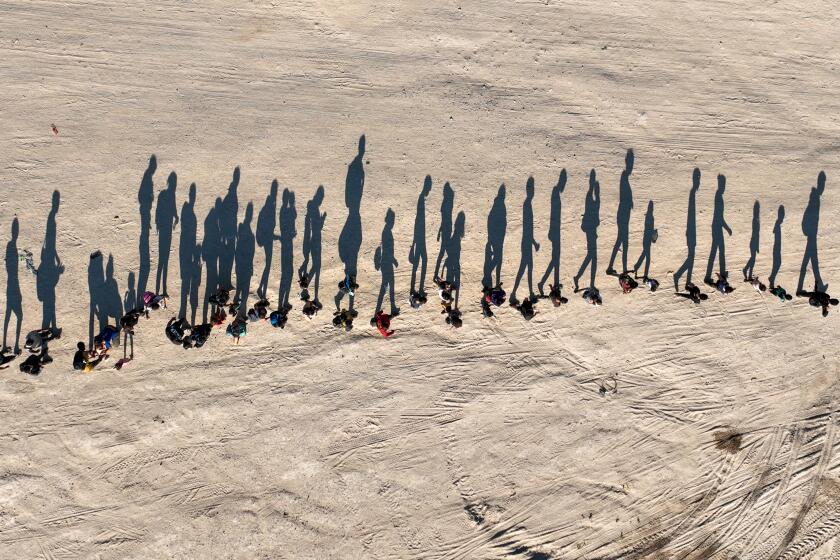What’s next for the disputed Texas immigration law on hold after whiplash court rulings?

WASHINGTON — The Texas immigration law that would empower the police to arrest people suspected of entering the U.S. illegally is on hold again while a different panel of the U.S. 5th Circuit Court of Appeals decides how to proceed.
The back-and-forth decisions, or nondecisions, from the appeals court have confounded the Biden administration and the Supreme Court, alarmed immigrant rights advocates and sparked outrage from the Mexican government.
It’s unclear whether or when the Texas law will go into effect. And the outcome will remain in doubt until the case makes a second trip to the Supreme Court.
At issue is the far-reaching question of whether Texas and other red states may adopt and enforce their own immigration laws. Texas Gov. Greg Abbott has championed the new and more aggressive approach to immigration enforcement, insisting the state must take action because of what he calls lax federal enforcement by the Democratic administration.
But doing so would require the Supreme Court to reverse course on decades of rulings that say the federal government, not the state, has the power to enforce the “entry and removal” of persons at the border.
The dispute has already divided judges on the conservative-dominated 5th Circuit.
On Feb. 29, a federal judge in Texas issued an injunction to block the new state law from taking effect on the grounds that it conflicted with federal law. When the state appealed, a three-judge motions panel of the 5th Circuit set aside the judge’s ruling and issued what it described as a “temporary administrative stay” that lasted for one week.
That allowed time for the Biden administration to ask the Supreme Court to intervene. But there was no clear ruling before the court.
On Tuesday, the Supreme Court in a 6-3 vote turned down the Biden administration’s plea to keep the law on hold.
The court said it “denied” the requests to block the Texas law but did not say why.
However, Justices Amy Coney Barrett and Brett M. Kavanaugh explained their votes by saying the 5th Circuit had yet to rule on the constitutionality of the Texas law, and they were unwilling to skip ahead to decide such an important question.
This case is “in a very unusual procedural posture,” Barrett wrote, because the first panel of judges did not issue a clear ruling. Instead, it issued “a temporary administrative stay” whose time had expired. She said the high court usually does not review such temporary orders, and “I would not get into that business.”
Four other conservative justices did not explain their votes, while the court’s three liberals voted in favor of the Biden administration’s request to block the Texas law for now.
Less than nine hours later, a three-judge appeals court panel in New Orleans said it would hold a hearing Wednesday morning to consider whether to put the Texas law on hold indefinitely while its constitutionality is decided.
This second panel, led by Chief Judge Priscilla Richman, had been scheduled to hear arguments April 3 on the constitutionality of the Texas law. By a 2-1 vote, it “dissolved” the earlier order from the motions panel of judges that would have allowed the state law to take effect immediately.
Justices approve a new Texas law that allows state and local police to arrest people suspected of illegally crossing the Rio Grande, and allows judges to return them to Mexico.
Besides Richman, an appointee of President George W. Bush, the appeals court panel includes Judges Andrew Oldham, a Trump appointee who worked as a lawyer for Gov. Abbott, and Judge Irma Ramirez, a new Biden appointee. Richman and Ramirez voted to keep the law on hold temporarily, while Oldham dissented.
Although the judges did not say how they will rule, Richman sounded notably skeptical of the Texas law. She said it looked similar to the Arizona immigration law that was blocked by the Supreme Court in 2012.
University of Texas law professor Stephen Vladeck said the Texas law known as Senate Bill 4 “is now on hold and is very likely to remain on hold at least through the April 3 oral argument on the merits.” And regardless of how the appeals court rules, “the Supreme Court is going to eventually have to resolve this case,” he said.
That may take many months, or even a year, if the high court agrees to hear arguments on the issue.
But this week’s procedural meltdown has put a spotlight on the different tasks before a regional appeals court.
On the one hand, the judges must hear appeals and issue rulings on disputed areas of law. The April 3 argument on the Texas case is an example of that.
But separately, the judges must also decide whether a new and disputed law or regulation may go into effect immediately or instead remain on hold while any appeals are pending. A rotating panel of three judges hears those motions seeking a temporary relief.
Increasingly, however, those temporary appeals are coming directly to the Supreme Court, forcing the justices to decide on a fast-track basis whether to allow a disputed measure to take effect.
Texas’ plan to arrest migrants who cross the U.S.-Mexico border illegally is on hold while the U.S. Supreme Court considers a challenge.
The justices have been wary of acting on these fast-track disputes. Justice Barrett in particular has objected to that process. She said the court should slow down and wait for a final ruling from the appeals court.
That in turn requires the appeals court panel to decide, and the 5th Circuit has yet to do that.
In the hours between the conflicting court decisions Tuesday, the Mexican government said it rejected any state or local attempts “to exercise migration control and to arrest and return nationals or foreigners to Mexican territory.”
One provision of SB 4 would authorize Texas judges to order the deportation of migrants found to have entered the state illegally.
“Mexico will not accept, under any circumstances, repatriations by the State of Texas,” the Mexican foreign ministry said.
On Wednesday, Mexican President Andrés Manuel López Obrador echoed that stance, calling into question how that portion of the Texas law would be enforced.
López Obrador labeled the GOP-backed measure the product of “anti-immigrant, anti-Mexican” sentiment and lashed out at the Texas governor without naming him.
The president compared the situation to the idea of the Mexican state of Tamaulipas — across from Texas’ Rio Grande Valley region — targeting Texans.
“It’s as if the governor of Tamaulipas applied a law against Texans who were visiting Mexico or passing through Tamaulipas,” López Obrador said.
Soldiers and razor-sharp metal at the Mexico-Texas border don’t deter migrants who traveled months to get there, as numbers of those fleeing to the U.S. soar.
But he didn’t predict any deterioration of relations with Washington, noting that the Biden administration is challenging the Texas law.
As the legal wrangling in the U.S. plays out during a presidential campaign focused heavily on immigration, some in Mexico view the Texas law and its widespread Republican support as an omen of how U.S.-Mexico tensions could rise should Donald Trump win a second term.
“This is an indication of what will come in November if Trump and the Republican Party win the election,” Arturo Sarukhan, a former Mexican ambassador to Washington, wrote on X, formerly Twitter.
Adam Isacson, an analyst with the Washington Office on Latin America, a research and advocacy group, noted Mexican and U.S. authorities’ common emphasis on federal jurisdiction in immigration policy.
“It underlines that the Biden and López Obrador administrations have a common adversary in Texas and in Trump-world,” Isacson wrote in an email. “For the Biden administration, it could mean a bit more leverage. They can tell their Mexican counterparts, ‘We’re the only thing standing between you and people who would carry out policies like S.B. 4, so we need you to cooperate on our priorities.’”
Savage reported from Washington and McDonnell from Mexico City.
More to Read
Sign up for Essential California
The most important California stories and recommendations in your inbox every morning.
You may occasionally receive promotional content from the Los Angeles Times.














